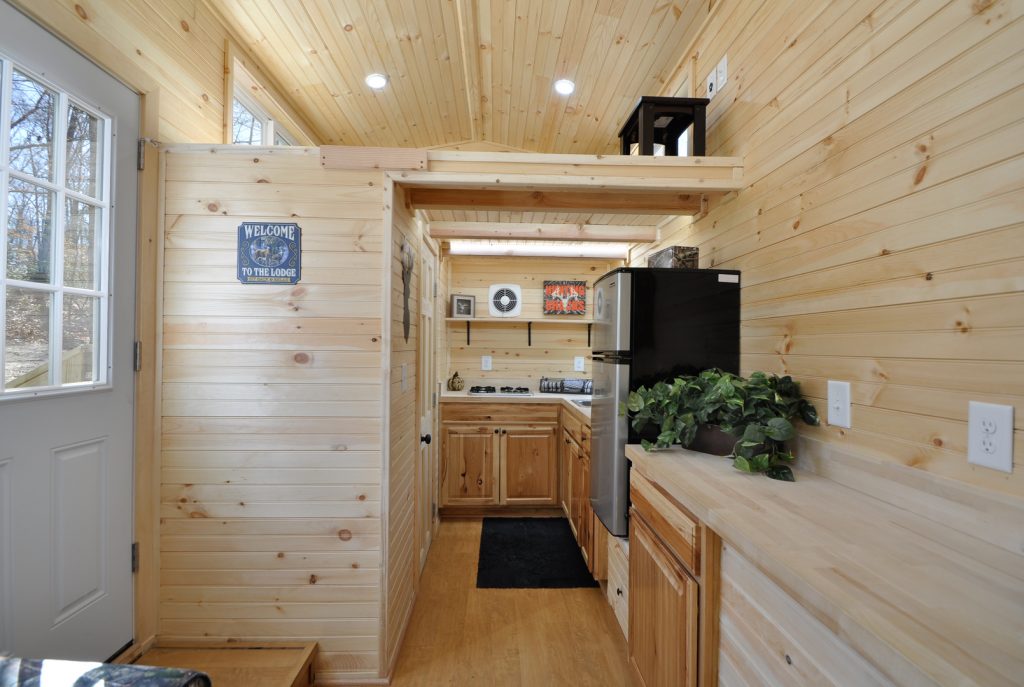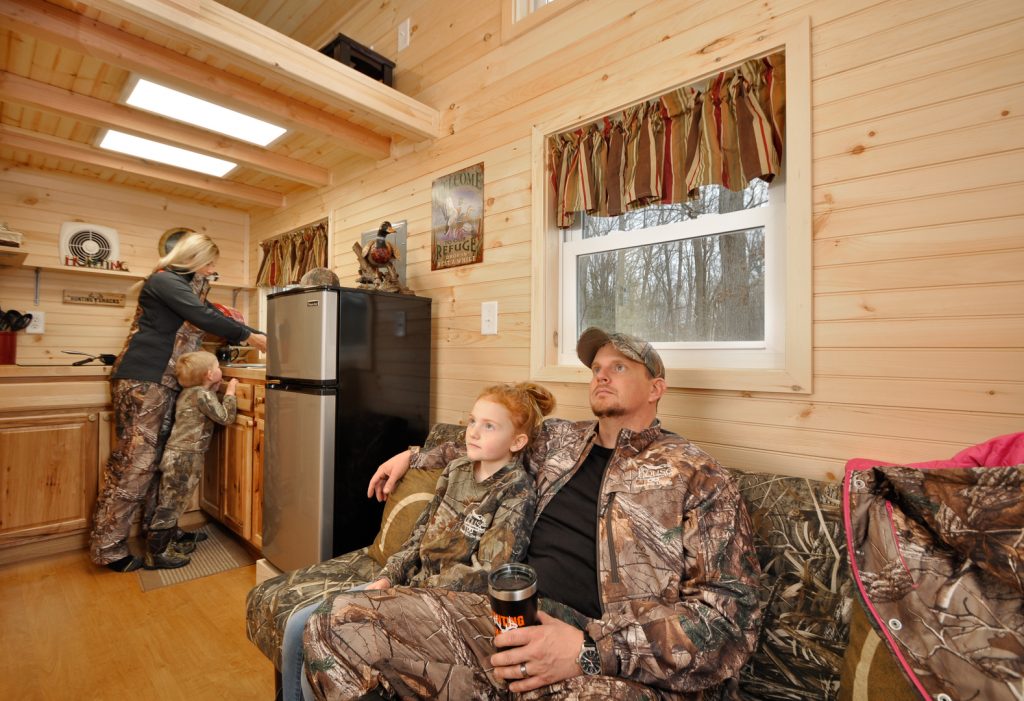If you’re not familiar with the tiny house movement, then emerge from the rock you’ve been living under for the last decade or so and listen up. They’re kind of a big deal.
Tiny homes have taken the housing market by storm. They’re popping up across the country in both rural and urban environments as an affordable and eco-friendly alternative to purchasing a traditional home in an increasingly tight economy. Downsizing appeals to some homeowners who want to minimize their carbon footprints, while others are motivated financially or have a desire for more freedom.
Typically measuring between 100 and 400 square feet, tiny homes come in all shapes, sizes and designs, from portable woodsy cabins to the Japanese-inspired “micro-apartments” you’ll find in Manhattan, San Francisco and even the Midwest.
One tiny home manufacturer and avid hunter decided to take this trend a step further and create his own, portable hunt camp.
“I have been a hunter for many, many years, and I knew there were things I wanted to see that campers could not give you,” said Kristopher Angstadt, CEO of Hunting Shacks and its parent company, Tiny House Building Company, LLC, in Fredericksburg, Virginia. “First off, I wanted something that is well-insulated. Second, I wanted to have something that felt like a cabin because I liked the cabin feel and wanted something that would fit in well in the woods and that hunters would find familiar.”

Hunting Shacks have the mobility of traditional campers, but boast the sturdiness and insulation of stick-build homes.
According to Angstadt, traditional campers only have a 6-7 insulation R-value in their walls, ceiling and floors, whereas Hunting Shacks are R-15 in the walls, R-19 in the ceiling and R-26 in the floor. If you hunt in areas that are primarily cold, that is a huge plus.
“We use traditional building materials that are meant to last and hold up for 30-plus years, unlike a camper where after five or six years, everything’s falling apart — the plastics, the aluminum, the glues, everything,” Angstadt said. “Inside a traditional camper, it’s all plastics and glues, and a lot of it has formaldehyde in it. We use all-natural products, so you don’t have those smells and those irritations that you get from campers.”
The interior walls are pine, both tongue and groove, and each Hunting Shack comes with the necessary features of a traditional home or RV, including a full bathroom with a good-sized shower, a kitchen with butcher block countertops and hickory cabinets and a living room/family area. Depending on which model is chosen, the features list continues to grow.
Choose From 3 Models
Angstadt’s Hunting Shacks are available in three models: Woodland, Timberland and Alpine, and prices for each range from $30,000 to $43,500. Financing is available.
- The Woodland model has a 4-foot front porch that’s perfect for sitting and relaxing in the evenings after a laborious day of prep and hunting. Its living room is TV- and cable-ready. It also features a king-sized, loft-style master suite as well as a twin-sized loft that can be used as a second bedroom or for storage. It totals 16 feet in length.
- Then, there’s the Timberland model: 20 feet long and able to go completely off the grid. That’s right. It can be entirely self-sufficient — perfect for the outdoorsman or hunter who is looking to get away from it all. It holds approximately 50 gallons of fresh water and has a battery bank as a back-up power source on top of the generator that powers the entire unit. It’s completely DC- and AC-wired, so it’s low-voltage, and when fully charged, the batteries can run for six or seven hours at a time. The real beauty of this model is that it features a walled propane water heater and on-demand hot water. You know what that means? The luxury of a hot shower — something hunters often look forward to once they return home form a long hunt. The propane also powers the gas-range stove, which is ideal for cooking up some of the meat you just harvested.
- The Alpine model is the tiniest Hunting Shack — totaling 13 feet in length and approximately 150 square feet of living space. It features a main-level bedroom; a sleeping/storage loft; a full kitchen with an induction cooktop, large sink and hickory cabinets; a bathroom with a relatively spacious shower and dry-flush toilet; and electric heating and air conditioning.
All of Angstadt’s Hunting Shacks are fully mobile, stick build homes (they are built just as sturdy as traditional houses, but are permanently attached to a trailer and equipped to travel at fast speeds).
“In our off-road model, I have a package on that where the tires are actually beefed-up, mud-type tires that have a sidewall to them,” Angstadt said. “You’ll be able to go into more remote locations with these tires because they’re thicker and more heavy-duty, which makes getting into remote areas much easier. And it’s a little more ground clearance, so you won’t be getting caught up on stumps or crossing over small logs.”
The best part about Hunting Shacks? They can go anywhere a traditional camper can go, both in terms of capability and legality. Maybe even further.
“Our homes are allowed in any RV park across the nation and are built to withstand the harshest conditions," Angstadt said. "I am not aware of any location where Hunting Shacks are not allowed to go. We also follow all the department of transportation guidelines which makes them completely street legal just like a traditional RV.”
Take the Comforts of Home With You on Hunts
Grand View Outdoors’ Editorial Director, Bob Robb, sees the appeal in these tiny hunt camps, too.
“These little shacks appear to be a niche item for sure, designed for folks who want to remain mobile yet have all the comforts of home while they’re in the woods hunting, fishing or camping,” Robb said. “There’s no doubt that the more comfortable your camp is, the more efficient you will be on the hunt.”
Angstadt isn’t just pushing these things because it’s his job; he’s a true believer. In fact, Hunting Shacks were born out of necessity for his own hunting experiences.
“What really brought me to doing this was terrible accommodations,” Angstadt said. “I bowhunt a lot with a friend of mine who’s a guide, and he’s a great guide, but he doesn’t have his own lodge. He would get locals to agree to let his hunters rent rooms by the night.”
Angstadt said he he once stayed in a house that had a serious mold issue. It was the worst accommodations he’d ever had. The place was cute as a button on the outside — nice, little brick home in the woods. But, oh, the mold. The furniture was wet inside. It smelt so bad. Angstadt didn’t sleep for two days and that was the straw that broke the camel’s back.
“I was tired of staying in these wedding venues and these random homes,” he said. “I realized that I needed to create something that I could take with me and hunt out of that would be my own home and would be set up the way I want. My gear is already in it. I don’t have to think about it. I don’t have to ask anybody or pay anybody. I can just put it behind my truck and go.”
Angstadt and his family enjoy hunting and camping together, so they have logged many hours testing Hunting Shacks first-hand.
“Mine is a family of hunters,” Angstadt said. “My wife bowhunts with me. So do my little ones. We teach our kids the true meaning of hunting. We eat what we kill; we don’t just do it for the fun of it. It’s a tradition in my family, and it’s going to be carried on with them. We have 125 acres that we own and hunt on that one of our hunting shacks goes to during hunting season. We get a lot of use out of it and really enjoy it.”

The Angstadts are a family of hunters, and they have enjoyed putting their own Hunting Shack to use.
Sold yet? If So, Here Are 5 Must-Haves for Your Hunting Shack:
- According to Angstadt, the ATV carrier is important if you need to carry anything with you on a hunt. “It’s so much safer and easier to get it behind the house than it is to get it in the truck with those huge ramps,” he said.
- Robb said with such a tiny space, less is more. “I’d want to make it feel like home without clutter. I’d choose one or two favorite old photos from past hunts to hang on the walls. On top of basic foods, you’d want some snacks and drinks for relaxing. You need a comfy place to sit. I’d keep kitchen gear to a minimum – every person has their own plate, bowl, cup, glass and silverware set and are responsible for washing and storing it.”
- If you’re a bowhunter or gun hunter, Angstadt said having a gun case or a hidden weapons compartment built into the house would come in handy. “I set mine up with the bow rack built into it. They don’t come furnished or decorated, so I would certainly keep enough wall space in there for gun storage and bow storage.”
- The space may be tiny, but that doesn’t mean you should do without. Incorporate any comforts from home that you’ve always wished you could have with you at the hunt camp. Get a TV that can recess into the wall and keep a few of your favorite DVDs on hand. Add a skylight to do some stargazing from your master suite. Stock up on some of your favorite books to pass the time. The possibilities go on and on. Just make it yours.
- The best part about these stick-built Hunting Shacks is they can be as customized as you like! Add an extra deck or a deer hoist, whatever you need to make the most of your hunting experience.
What do you think of these Hunting Shacks? Can you see yourself or your family using one? Let us know in the comment section below, or email me at ahoward@grandviewmedia.com.
Photos featured in this article are courtesy of Hunting Shacks.







